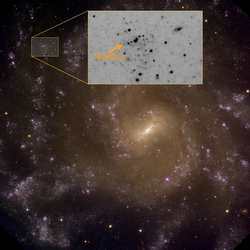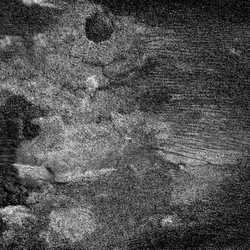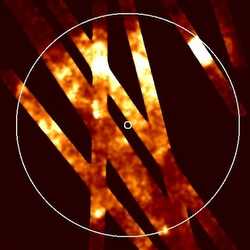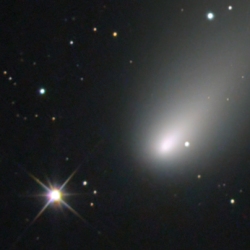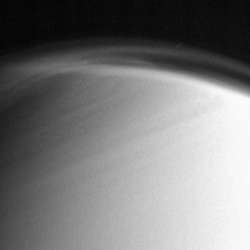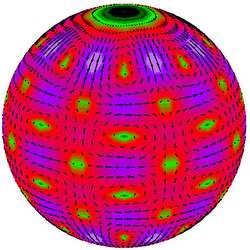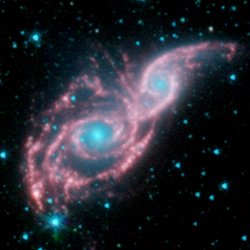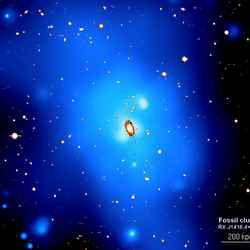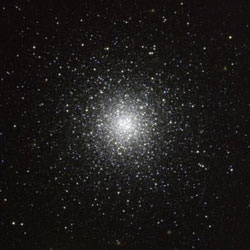
M53. Image credit: Credit: REU Program/NOAO/AURA/NSF. Click to enlarge.
Greetings, fellow SkyWatchers! Have you been following the comet’s trail? If not, there’s observing tips on how to locate 73/P Schwassmann-Wachmann easily. Get out your binoculars or telescopes as we prepare to journey to the Moon and beyond ths week – because…
Here’s what’s up!
Tuesday, May 2 – UPDATE: For those interested in the whereabouts of the C-component of comet 73/P Schwassmann-Wachmann, look no further than Hercules. As the week opens, you’ll find it cruising through the center of the “keystone” (see SkyHound’s map) and easily visible to small binoculars under less than optimal conditions. Be sure to let the constellation rise at least to the upper third of the sky before attempting observations and enjoy!
For early evening viewers, tonight’s Moon provides a great opportunity to visit telescopically with some smaller features located within the fully disclosed Mare Crisium area. Look for two bright mountainous areas near the terminator on the central western border of Crisium. These two regions include the Olivium and Lavinium Promontoriums. Voyaging across Crisium’s smooth floor toward the east, you will see the small punctuations of Craters Picard to the south and Pierce to the north. Try to follow these features over the lunar cycle and see how many nights you can continue to see them.
As the Moon sets, let’s have a look at three entirely different studies around the constellation Corvus, the “Crow.”
The most recognizable shape of Corvus is an irregular box of visible stars southwest of Spica. The southeastern-most star is Beta Corvi. Look around two finger-width’s south for faint star SAO 180965. By aiming your low power scope or large binoculars there, you will find 8.2 magnitude globular cluster M68 to the northeast. The several hundred thousand stars comprising M68 spread out over a region 110 light-years in diameter. Located about 35,000 light-years away, it’s a nice challenge.
Now head for the northeast star in the box, and you notice that it’s a nice visual pair – Eta and Delta. Around two finger-widths southwest will put you in the area to find planetary nebula NGC 4361. This fairly large, irregular, 10th magnitude planetary has a faint central star surrounded by a “square fuzzy shell” of nebulosity. Notice how it appears to flare outwardly as the eye moves about the field of view. Perhaps there’s more to this planetary than meets the eye!
To locate our next study, just head 11 degrees (very slightly more than a fist width) due west of Spica to locate the Sombrero Galaxy – M104. Showing surprising structure through binoculars and small scopes, this 8.3 magnitude, near edge-on spiral is one of the most massive known. Mid-sized scopes should look for M104’s large central bulge and extended tightly wound arms. Viewers with large aperture will easily see the dark lane breaking across the galaxy’s equator through the bulge of the nucleus.
Be sure to look for a striking “Scorpio-shaped” asterism of equally bright stars just northwest of the mighty “Sombrero!”
Wednesday, May 3 – Tonight the Moon is the prominent sky feature, so why not venture to the surface and visit one of the oldest features left on the visible lunar side? Start by identifying two prominent craters in the southeast quadrant – Metius and Fabricus. While viewing the area around them, note that Fabricus’ walls actually intrude on Metius – pointing to a younger age of formation. Around Fabricus, but not including Metius, is the boundary of a mountain-walled plain extending into the terminator. High power will reveal many breaks in its hexagonal walls surrounding a floor marred by many smaller craters and fine fissures. This is Jannsen. Look for three prominent interior craters, as well as an ancient rima falling near the shadow’s edge. It may not seem exciting, but remember Jannsen could go back to the time when the Moon first formed – more than four billion years ago!
Even under bright skies, we can still study open clusters – right? Well, not really. Have you noticed how few there are in the spring sky? In fact, the ones that can be seen are rapidly dropping off the edge of the world to the west. (Oops, there goes another one!) They are associated with the winter Milky Way. That’s why open clusters have another name – “galactic clusters!”
Instead, let’s have a look at another interesting subset of things visible in the night sky – galaxies located near bright stars. For instance, Phecda is the southeastern star in the bowl of the Big Dipper, but look again. If you center on Phecda and shift it slightly northwest, you will turn up 9.8 magnitude M109, which is over 55 million light-years further away than its “companion” star.
Tonight Jupiter, with its four bright moons and striking cloudtop features, comes into its own as it reaches opposition. Be prepared for whatever sky conditions permit you to see among the many fine features associated with this mirthful member of our solar family!
Thursday, May 4 – Tonight we’ll continue our lunar explorations as we look for the “three ring circus” of easily identified craters – Theophilus, Cyrillus, and Catherina. Are you ready to discover a very conspicuous lunar feature that was never officially named? Cutting its way across Mare Nectaris from Theophilus to shallow crater Beaumont in the south, you’ll see a long, thin, bright line. What you are looking at is an example of a lunar dorsum – nothing more than a wrinkle or low ridge. Chances are good that this ridge is just a “wave” in the lava flow that congealed when Mare Nectaris formed. This particular dorsa is quite striking tonight because of low illumination angle. Has it been named? Yes. It is unofficially known as “Dorsum Beaumont,” but by whatever name it is called, it remains a distinct feature you’ll continue to enjoy!
It’s still a bit early to begin viewing Jupiter, so let’s look at a double star while we wait for it to gain sky position. Named in honor of King Charles II of England by Astronomer Royal Edmund Halley in 1725, Cor Caroli “the Heart of Charles” (Alpha Canes Venatici) is a splendid example of a bright easily resolved “double of color.” At magnitude 2.9, Cor Caroli is best found by moving a little more than a fist width southwest of Eta Ursa Majoris (Alkaid.) Although the pair is not resolvable in low power binoculars, just about any telescope will distinguish between the pale yellow primary and nicely “spaced” blue secondary.
Tonight Jupiter appears some 44.6 arc seconds in diameter – almost twice as large as the planet Mars ever appears from Earth. At its current apparent size, it only takes 40x magnification to make the planet’s disk appear the size of the Moon unaided. This magnification will reveal the three main cloudtop features in the planet’s atmosphere. Look for the darkly textured northern and southern equatorial belts (NEB & SEB) separated by the bright equatorial zone (EZ). These belts and zone were first seen as early as 1664 and several astronomers including Niccolo Zucchi, Gian Dominico Cassini, Robert Hooke, and Gilles-François Gottigniez are credited with their discovery. This same magnification easily distinguishes the four bright satellites as well. These moons were first reported by Galileo Galilei after a week of observing beginning January 7, 1610.
Friday, May 5 – On this date in 1961, Alan Shepard became the first American in “space.” It was only a 15 minute suborbital ride aboard Mercury craft Freedom 7… But what a ride!
For moon watchers tonight, we celebrate 36 years of space exploration as the Apollo 11 landing site now becomes visible. For telescopes and binoculars the landing area will be found near the terminator along the southern edge of Mare Tranquillitatis. For those who would like a real challenge, try spotting small craters Armstrong, Aldrin, and Collins just east of easy craters Sabine and Ritter. No scope? No problem. Find the dark round area on the lunar northeastern limb – Mare Crisium. Then locate the dark area below that – Mare Fecundatatis. Now look mid-way along the terminator for the dark area that is Mare Tranquillitatis. The bright point west where it joins Mare Nectaris further south is the target for the first men on the Moon.
We were there…
Still up for adventure? What about an observation that happened more than 240 years ago? Like Charles Messier, Johan Hevelius (1611 – 1687) kept a log of things seen while sweeping the night sky using a small telescope. The third object on Hevelius list of 16 “Nebulosae” (designated Hev 1496) came to the attention of Charles Messier who – based on Hevelius’ description – swept the same part of the sky in an attempt to locate it. Failing to discover anything nebulous in the region, Messier added the one and only double star to his famed list as M40.
Start at Mizar and Alcore, and hop about a finger-width northwest. Look for a pair of 9th magnitude stars separated by 49 arc seconds with the fainter 9.3 magnitude component oriented east-northeast. Try turning high power binoculars toward this pair – it’s just possible you may re-discover Hevelius’ “Nebulosa!”
Saturday, May 6 – Tonight is a wonderful chance for binoculars and small scopes to study the Moon. Craters Aristotle and Eudoxus to the north are easily apparent, along with the Caucasus and Apennine mountain range. Looking for a spectacular lunar feature? Look no further than the Valles Alpes. Known also as the “Alpine Valley,” this deep slash across the northern surface is easily visible and lighting conditions will be just right to explore its 1.5 to 21 kilometer wide, and 177 kilometer long expanse.
Even with bright moonlit skies, we still have the opportunity to study doubles – so let’s head towards Corvus and see if we can collect enough starlight to resolve Delta Corvi. Look for a distant and relatively faint companion!
Sunday, May 7 – Tonight, we’ll have a look at crater Eratosthenes. Just slightly north of lunar center and on the terminator, this easily spotted feature dangles at the end of the Apennine Mountain range like a yo-yo caught on a string. Its rugged walls and central peaks make for excellent viewing. If you look closely at the mountains northeast of Eratosthenes, you will see the high peak of Mons Wolff. Named for the Dutch philosopher and mathematician, this outstanding feature reaches 35 kilometers in height. To the southwest of Eratosthenes you may also spot the ruined remains of crater Stadius. Very little is left of its walls and the floor is dotted with small strikes. Near the twin pair of punctuations to its south lie the remains of Surveyor 2!
Two nights ago, Jupiter came as close as it’s going to get to Earth. Now let’s have a “deeper” look at this giant planet. There’s much more to be seen at high power and through stable skies. Wait until Jupiter gains some altitude, then magnify to catch more of those whirling “bands on the run!”
At mid-magnifications the two equatorial belts (NEB and SEB) can be seen flanked by two lesser belts – the North Temperate Belt (NTB) and the South Temperate Belt (STB). These thin and sometimes almost undetectable belts are found at latitudes that move more slowly around the planet’s girth than its equator. Like the NEB and SEB, they come about as a combination of conditions – winds, temperature, and chemical composition. They gang up to darken the albedo (reflectivity) of different parts of Jupiter’s atmosphere under the influence of all the energy unleashed by Jupiter’s less than ten hour rotation.
While observing Jupiter’s features, keep in mind that you are looking through various depths into its atmosphere. In general, things of a blue tint are deeper than things brown. The reds are highest – just above the whites. Unlike our Earth, most of the energy driving “weather” on Jupiter comes from Jupiter itself – since it emits more heat energy than it receives from the Sun. Of course, there is that “whirling dervish” of a rotational speed – some 45,000 kilometers per hour!
May all your journeys be at light speed… ~Tammy Plotner with Jeff Barbour.
